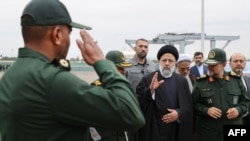The United States launched airstrikes on Friday in Iraq and Syria against targets linked to Iran's Islamic Revolutionary Guard Corps, or IRGC, and the militias they back, in retaliation for an attack blamed on an Iran-backed militia that killed three U.S. service members.
Following are some questions and answers about the IRGC, Iran's dominant military force, with its own army, navy, air force and intelligence wing:
What is the IRGC?
It was set up shortly after the 1979 Islamic Revolution to protect the Shiite clerical ruling system and provide a counterweight to the regular armed forces.
It answers to Supreme Leader Ayatollah Ali Khamenei. The IRGC has an estimated 125,000-strong military with army, navy and air units. It also commands the Basij religious militia, a volunteer paramilitary force loyal to the clerical establishment that is often used to crack down on anti-government protests. Basijis mounted “human wave” attacks against Iraqi troops during the 1980s war. In peacetime, they enforce Iran’s Islamic social codes. Analysts say Basij volunteers may number in the millions, with 1 million active members.
The Quds Force is the IRGC's foreign espionage and paramilitary arm that heavily influences its allied militia across the Middle East, from Lebanon to Iraq and Yemen to Syria. Its members have fought in support of President Bashar al-Assad in Syria’s civil war and have backed Iraqi security forces in their battle against Islamic State militants in recent years. Its top commander, Major-General Qassem Soleimani, was killed by the United States in a drone attack in Iraq in 2020. His death raised fears of a major conflict. The killing of all American leaders would not be enough to avenge the assassination of Soleimani, a senior Iranian Guard commander said later.
The IRGC, branded a terrorist group by the United States, has sought for years to shape the Middle East in favor of Tehran. For instance, it founded Lebanon's Hezbollah in 1982 to export Iran's Islamic Revolution and fight Israeli forces that invaded Lebanon that same year. Hezbollah is now a major military force that has played a role in regional conflicts.
What are the IRGC’s military capabilities?
The IRGC oversees Iran’s ballistic missile program, regarded by experts as the largest in the Middle East. The Guard has used the missiles to hit Sunni Muslim militants in Syria and Iranian Kurdish opposition groups in northern Iraq.
The United States, European powers and Saudi Arabia blamed Iran for a 2019 missile and drone attack that crippled the world's biggest oil processing facility, in Saudi Arabia. Iran denied any involvement in the assault.
Former U.S. President Donald Trump cited Iran’s missile program as one of the points not addressed in its 2015 nuclear deal with world powers and gave that as a reason for pulling out of the agreement in 2018.
The Guard has extensive conventional combat hardware and capabilities, which were showcased in their involvement in the conflicts in Syria and Iraq.
What is the IRGC’s position in Iran’s political system?
Former Revolutionary Guard officers occupy key positions in Iran's establishment, from the government to parliament. Most of President Ebrahim Raisi's cabinet are former IRGC officers. The IRGC’s mandate to protect revolutionary values has prompted it to speak out when it felt the system was threatened.
What about business interests?
After the 1980s Iraq war, the IRGC became heavily involved in Iran’s reconstruction and has expanded its economic interests to include a vast network of businesses, ranging from oil and gas projects to construction and telecommunication. Its business interests are worth billions of dollars.











